- 16 AOÛT
- INDI-UNI : 
PRE-INSCRIPTION : 15 Juin – 31 Août
PRE-REGISTRATION: June 15th - August 31st
- TURQUIE – 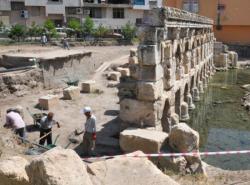 Sarikaya - Archeologists are bringing to daylight the first thermal treatment center in Anatolia, a local deputy mayor said on Sunday. Deputy Mayor Sadettin Ozturk of Sarikaya town of the central province of Yozgat said archeologists were carrying out excavations to unearth "Basilica Therma", the first thermal treatment center in Anatolia. "A snake figure on the construction proves that this place was used as a treatment center," Ozturk told AA correspondent. Five architectural pieces have been discovered in excavations so far. Dating to 3,000 years ago, the thermal facility is one of unique constructions built during the Early Roman age.
Sarikaya - Archeologists are bringing to daylight the first thermal treatment center in Anatolia, a local deputy mayor said on Sunday. Deputy Mayor Sadettin Ozturk of Sarikaya town of the central province of Yozgat said archeologists were carrying out excavations to unearth "Basilica Therma", the first thermal treatment center in Anatolia. "A snake figure on the construction proves that this place was used as a treatment center," Ozturk told AA correspondent. Five architectural pieces have been discovered in excavations so far. Dating to 3,000 years ago, the thermal facility is one of unique constructions built during the Early Roman age.
http://www.worldbulletin.net/?aType=haber&ArticleID=77179
- FRANCE – Famars - Sur les trente-quatre hectares de la ZAC, onze seront étudiés à la loupe. En 2009 et 2010, la ZAC avait fait l'objet d'un diagnostic archéologique afin de sonder le sol et vérifier la présence de vestiges. « Au nord du site, nous n'en avons pas trouvé », explique Raphaël Clotuche. En revanche, « au centre et au sud du futur Technopôle, nous avons décelé des vestiges qui plus est, bien conservés », se réjouit l'archéologue. Sous le sol ocre et limoneux, dorment des maisons construites en bloc de grès ainsi qu'un atelier de taille de grès, « une pièce unique en France », les anciens abattoirs de la ville, des cadavres d'animaux, une tannerie ou encore des céramiques. « À l'époque, Famars était une ville connue pour ses exportations de céramiques. D'ailleurs, sur cet emplacement il y a près de sept hectares de four de potier. » Sous terre, les archéologues ont également identifié une fabrique d'huile de mâchoire, « un corps gras qui servait à entretenir le cuir », un atelier de tabletterie, « qui autrefois servait à fabriquer des objets en os comme des peignes, des charnières de porte, ou encore des épingles ». Des indices du passé qui permettront aux archéologues de retracer l'histoire de Famars mais aussi de Valenciennes. « Famars, c'est le passé antique de Valenciennes. On évalue sa création en l'an 50 après J.-C., poursuit Raphaël Clotuche. Valenciennes, quant à elle, est une ville relativement récente qui n'a pas connu l'antiquité et n'a commencé son existence qu'au Moyen âge. »
http://www.lavoixdunord.fr/Locales/Valenciennes/actualite/Valenciennes/2011/08/16/article_a-famars-les-fouilles-sur-le-site-du-tec.shtml
- FRANCE – Arras - C'est parti pour trois campagnes de fouilles, de six à sept semaines chacune, au pied des tours de Mont-Saint-Éloi. Jean-Michel Willot, à la tête du service d'archéologie préventive du Département, peut voir loin. « Tout reste à faire. Les textes ne suffisent pas », résume l'homme, pelle en main, à deux pas des fondations mises au jour en 2010. Les archéologues ont dressé un début de plan de l'église de 1750 : « Cette année, on va compléter le plan, à l'emplacement du choeur, et du colatéral est. On va essayer de comprendre le chantier de l'église classique, les matériaux, la manière de construire, quel type de fondations ont été utilisées. On va essayer d'établir une chronologie », annonce Jean-Michel Willot, qui espère aussi repérer des restes de l'abbaye gothique antérieure. Mais où ? À ce jour, un groupe travaille sur une zone où sont dégagées les fondations d'un ensemble de chapelles rayonnantes de l'église de 1750. D'autres secteurs d'intervention, sur les 2 500 m² du terrain, ont été ciblées grâce à des recherches documentaires. À l'arrière de l'église, les restes de bâtiments conventuels apparaissent. Ici, « un bâtiment partiellement détruit lors de la construction de l'église classique. Ici, on voit l'effondrement de la voûte du cellier », indique M. Willot. Près des tours, un groupe s'affaire autour de sépultures. Une dizaine. Les archéologues pensent pouvoir en trouver une cinquantaine. L'objectif : « Connaître les populations qui vivaient là. » Après la découverte des ossements, leurs analyses livreront peut-être autant de secrets que les pierres enfouies.
http://www.lavoixdunord.fr/Locales/Arras/actualite/Secteur_Arras/2011/08/16/article_les-archeologues-a-la-recherche-de-l-egl.shtml
- FRANCE – 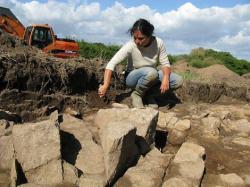 Toul er Pry - Le projet de lotissement s'est mis en place à Toul-er-Pry, il y a deux ans. Lors des fouilles, il a été trouvé une stèle gauloise piquetée en arrondi et des monolithes, dans le muret de la parcelle de 8 000 m 2 . De ce fait, le Service régional de l'archéologie à Rennes a demandé un diagnostic archéologique à l'Institut national de recherche en archéologie préventive. Le diagnostic archéologique se termine. Les archéologues ont fait faire douze tranchées de 20 m de long sur 3 m de large. Leur profondeur varie de 60 cm à 1,80 m, pour atteindre le substrat (arène granitique) ou les structures archéologiques détectées. Sept ont déjà été rebouchées et quatre à cinq sont positives, c'est-à-dire qu'elles contenaient des objets. Les archéologues termineront leurs explorations en milieu de semaine. Ce qui ressort globalement, c'est la détection d'un site néolithique final, c'est-à-dire de l'Age de la pierre polie, celui des premiers agriculteurs sédentaires, environ 3 000 ans avant Jésus-Christ. Il a été découvert des trous de poteaux, c'est-à-dire des empreintes de bâtiments, associés à des fosses dépotoirs. Dans l'une se trouvaient environ dix kilos de céramique, qui permettent une datation certaine, et dans l'autre, des fragments de meules ou éléments, qui servaient à tailler le silex. Dans une autre tranchée, il a été découvert des vestiges d'extraction de blocs, peut-être le site d'une carrière. Ailleurs encore, on trouve des structures de pierres chauffantes. Ce sont des pierres disposées en rond qui ont été chauffées, comme des foyers, pour cuire des aliments éventuellement.
Toul er Pry - Le projet de lotissement s'est mis en place à Toul-er-Pry, il y a deux ans. Lors des fouilles, il a été trouvé une stèle gauloise piquetée en arrondi et des monolithes, dans le muret de la parcelle de 8 000 m 2 . De ce fait, le Service régional de l'archéologie à Rennes a demandé un diagnostic archéologique à l'Institut national de recherche en archéologie préventive. Le diagnostic archéologique se termine. Les archéologues ont fait faire douze tranchées de 20 m de long sur 3 m de large. Leur profondeur varie de 60 cm à 1,80 m, pour atteindre le substrat (arène granitique) ou les structures archéologiques détectées. Sept ont déjà été rebouchées et quatre à cinq sont positives, c'est-à-dire qu'elles contenaient des objets. Les archéologues termineront leurs explorations en milieu de semaine. Ce qui ressort globalement, c'est la détection d'un site néolithique final, c'est-à-dire de l'Age de la pierre polie, celui des premiers agriculteurs sédentaires, environ 3 000 ans avant Jésus-Christ. Il a été découvert des trous de poteaux, c'est-à-dire des empreintes de bâtiments, associés à des fosses dépotoirs. Dans l'une se trouvaient environ dix kilos de céramique, qui permettent une datation certaine, et dans l'autre, des fragments de meules ou éléments, qui servaient à tailler le silex. Dans une autre tranchée, il a été découvert des vestiges d'extraction de blocs, peut-être le site d'une carrière. Ailleurs encore, on trouve des structures de pierres chauffantes. Ce sont des pierres disposées en rond qui ont été chauffées, comme des foyers, pour cuire des aliments éventuellement.
http://www.ouest-france.fr/actu/actuLocale_-Le-diagnostic-archeologique-a-Toul-er-Pry-touche-a-sa-fin-_56055-avd-20110812-61062640_actuLocale.Htm
- BULGARIE – Maritsa - Archaeological finds uncovered during 14 years of work on the Maritsa motorway have gone on display at the museum in Chirpan, a town in south-central Bulgaria in the Stara Zagora region. Archaeologists from Sofia University, working with colleagues from Chirpan and Stara Zagora, believe that they have found the remains of the medieval town of Blisnos. The once-populous town existed until some time in the late 12th or early 13th centuries. The exhibition at the Chirpan museum includes many of the more than 3000 items of metal, clay, bone and glass found during work around the area where the motorway was being built. The finds show that people inhabited the area as early as the late Neolithic age, according to archaeologists who participated in the digs. Also found was a fifth millennium BCE Thracian sanctuary, found near the Kaleto fortress close to the village of Koshnitse. The sanctuary is believed to have been in use from the late stone age through the bronze age up to the time of antiquity. An entire wall of the Kaleto fortress has been uncovered. The fortress was built in the sixth century CE by the Byzantine emperor Justinian to guard the main Roman road from Philipopolis to Adrianople to Constantinople - in modern terms, from Plovdiv to Edirne and Istanbul.
http://www.sofiaecho.com/2011/08/16/1139891_archaeology-finds-from-work-on-bulgarias-maritsa-highway-on-display
- USA – 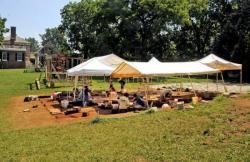 Montpelier - Matthew Reeves, director of archaeology at Montpelier, is leading a three-year excavation to locate and compare the different types of slave quarters. The three sites to be examined were all occupied by Montpelier slaves from 1810 into the 1830s. They include the South Yard, quarters for house slaves, just south of the mansion; the Stable Quarter, housing for skilled artisans, between the South Yard and the Montpelier Visitor Center; and the Field Quarter, housing for field slaves, just downhill from the visitor center. This summer, to help interpret the area, Montpelier has erected timber-frame outlines of slave structures in the House Quarter.
Montpelier - Matthew Reeves, director of archaeology at Montpelier, is leading a three-year excavation to locate and compare the different types of slave quarters. The three sites to be examined were all occupied by Montpelier slaves from 1810 into the 1830s. They include the South Yard, quarters for house slaves, just south of the mansion; the Stable Quarter, housing for skilled artisans, between the South Yard and the Montpelier Visitor Center; and the Field Quarter, housing for field slaves, just downhill from the visitor center. This summer, to help interpret the area, Montpelier has erected timber-frame outlines of slave structures in the House Quarter.
http://fredericksburg.com/News/FLS/2011/082011/08162011/645639
- USA – 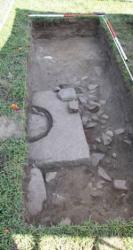 Lowell - As part of an ongoing study of the Irish who found their way to Lowell, Massachusetts before and after Ireland’s Great Famine, students from Queen’s University, Belfast traveled to Lowell last week to join their UMass Lowell counterparts in continuing to excavate the area around St. Patrick’s Church on Suffolk St. The collaborative venture between the two colleges continued with a closer examination of the site which, in last August’s initial dig, unearthed over 1,350 artifacts including children’s marbles, rosary beads, tobacco pipes, fruit jar remnants and oyster shells, shedding light on the recreational, dietary and cooking habits of the settlers. The project focuses on Hugh Cummiskey, from the small townland of Crossan, near Dromore in Co. Tyrone, and his team of 30 Irish laborers who in 1822 made the foot-trek from Charlestown with a contract to widen and deepen the canals along the Merrimack River. Settling in what became Lowell, their dangerous work helped to power the textile mills which made the town a cloth-making hub. The initial settlement was a shanty town called The Acre, where in 1831 they built a wooden church named after St Patrick, the rebuilt version of which hosts the site of the excavation project. They hit pay dirt straight away; one trench unearthed a large stone base which may have borne the weight of a chimney as high as two storeys, and the other revealed a layer of clay which was likely the floor of the house for which the team was searching. A new chapter in the history of the Irish settlers has been written, and the next set of questions now lie waiting to be answered.
Lowell - As part of an ongoing study of the Irish who found their way to Lowell, Massachusetts before and after Ireland’s Great Famine, students from Queen’s University, Belfast traveled to Lowell last week to join their UMass Lowell counterparts in continuing to excavate the area around St. Patrick’s Church on Suffolk St. The collaborative venture between the two colleges continued with a closer examination of the site which, in last August’s initial dig, unearthed over 1,350 artifacts including children’s marbles, rosary beads, tobacco pipes, fruit jar remnants and oyster shells, shedding light on the recreational, dietary and cooking habits of the settlers. The project focuses on Hugh Cummiskey, from the small townland of Crossan, near Dromore in Co. Tyrone, and his team of 30 Irish laborers who in 1822 made the foot-trek from Charlestown with a contract to widen and deepen the canals along the Merrimack River. Settling in what became Lowell, their dangerous work helped to power the textile mills which made the town a cloth-making hub. The initial settlement was a shanty town called The Acre, where in 1831 they built a wooden church named after St Patrick, the rebuilt version of which hosts the site of the excavation project. They hit pay dirt straight away; one trench unearthed a large stone base which may have borne the weight of a chimney as high as two storeys, and the other revealed a layer of clay which was likely the floor of the house for which the team was searching. A new chapter in the history of the Irish settlers has been written, and the next set of questions now lie waiting to be answered.
http://www.irishemigrant.com/ie/go.asp?p=story&storyID=9815
- HAWAII – 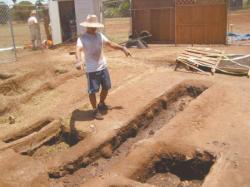 Lahaina - The Friends of Moku'ula Inc. hopes to present to Maui County planners next month the first phase of its archaeological restoration and information center along Front Street. The initial phase includes a complete restoration of the former home of Hawaii's kings and queens, or alii, its wetlands and other water features, and an interpretive and community learning center. When the project moves into the next phase, the group will do much of the work to restore the original wetland and fishpond surrounding the 1-acre island of Moku'ula, called Mokuhinia. Moku'ula is oblong, and the restored area would run parallel to and makai of Front Street. About three feet below the contemporary surface lies historic Moku'ula. It once had a cavern and homes for royalty and their court. The large fishpond was connected to a series of ocean- and spring-fed canals and acted as a sort of moat around Moku'ula, archaeologists have said. The island also had a shrine dedicated to the family goddess, Mo'o Akua Kihawahine, and the alii home might still be buried somewhere under a nearly abandoned baseball field across the street from the 505 Front Street shopping center. The archaeological dig began in the spring of last year. As workers have dug up the site, "spoonful by spoonful" over the past year, they've also come across a couple of possibly important finds, including a brick that may be part of a former palace and a piece of rope. The rope may have a connection to the spruce pier already discovered at the site and believed to have been a canoe dock for the island. In addition, they've found cut stones for buildings and the tooth of a young dog believed to have been used as part of a sacrifice to Kihawahine. The tiny section of hand-woven rope could have been used for anything from tying up canoes to the pier extending from the Moku'ula island to securing palm fronds to a hale, employees and volunteers guessed. It's believed that Moku'ula simply was abandoned by the alii after they moved their government to Honolulu in the mid-1800. Most of the valuables were shipped to Oahu.
Lahaina - The Friends of Moku'ula Inc. hopes to present to Maui County planners next month the first phase of its archaeological restoration and information center along Front Street. The initial phase includes a complete restoration of the former home of Hawaii's kings and queens, or alii, its wetlands and other water features, and an interpretive and community learning center. When the project moves into the next phase, the group will do much of the work to restore the original wetland and fishpond surrounding the 1-acre island of Moku'ula, called Mokuhinia. Moku'ula is oblong, and the restored area would run parallel to and makai of Front Street. About three feet below the contemporary surface lies historic Moku'ula. It once had a cavern and homes for royalty and their court. The large fishpond was connected to a series of ocean- and spring-fed canals and acted as a sort of moat around Moku'ula, archaeologists have said. The island also had a shrine dedicated to the family goddess, Mo'o Akua Kihawahine, and the alii home might still be buried somewhere under a nearly abandoned baseball field across the street from the 505 Front Street shopping center. The archaeological dig began in the spring of last year. As workers have dug up the site, "spoonful by spoonful" over the past year, they've also come across a couple of possibly important finds, including a brick that may be part of a former palace and a piece of rope. The rope may have a connection to the spruce pier already discovered at the site and believed to have been a canoe dock for the island. In addition, they've found cut stones for buildings and the tooth of a young dog believed to have been used as part of a sacrifice to Kihawahine. The tiny section of hand-woven rope could have been used for anything from tying up canoes to the pier extending from the Moku'ula island to securing palm fronds to a hale, employees and volunteers guessed. It's believed that Moku'ula simply was abandoned by the alii after they moved their government to Honolulu in the mid-1800. Most of the valuables were shipped to Oahu.
http://www.mauinews.com/page/content.detail/id/552456/-Spoonful-by-spoonful---Moku-ula-slowly-returns.html?nav=10